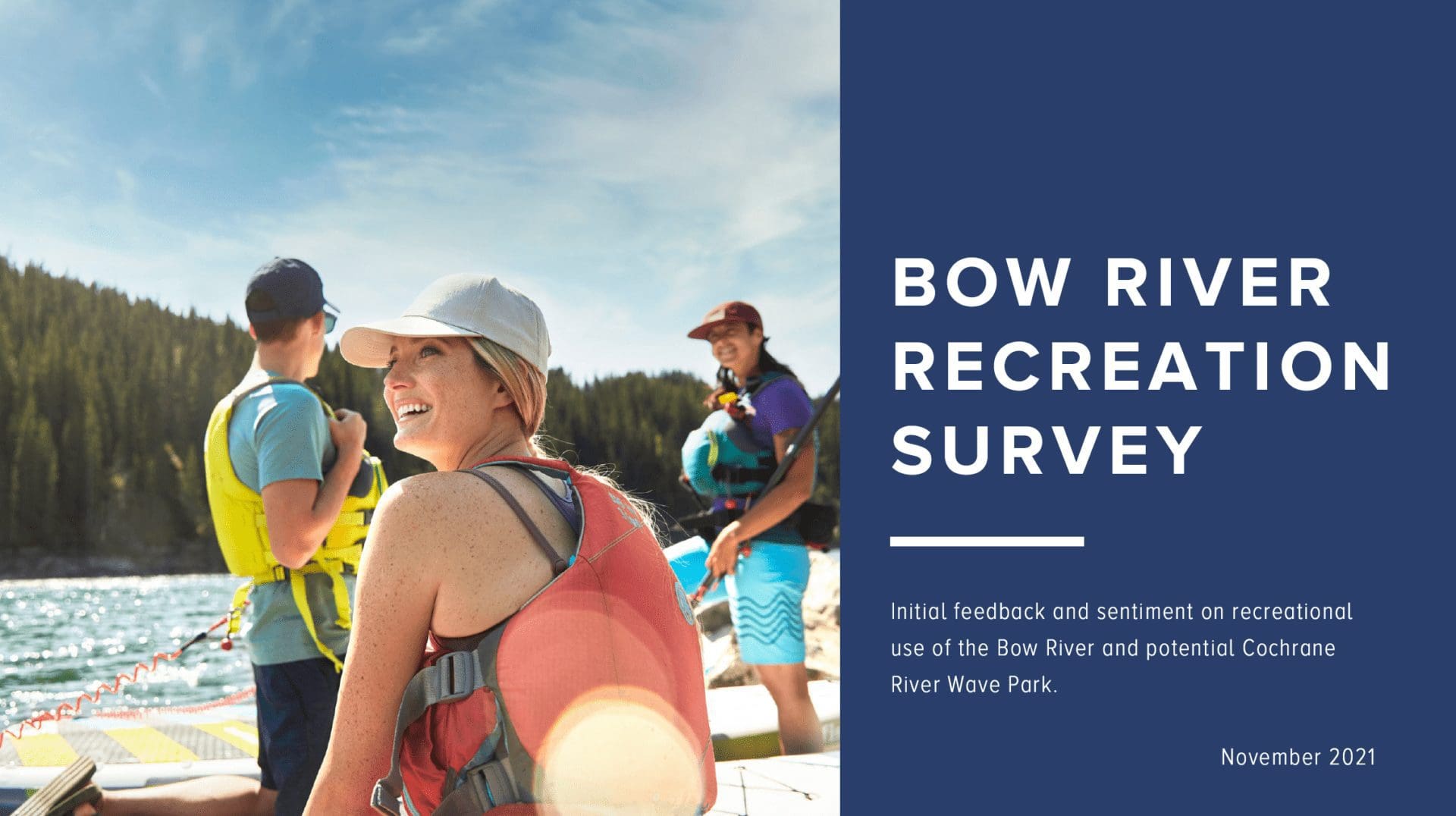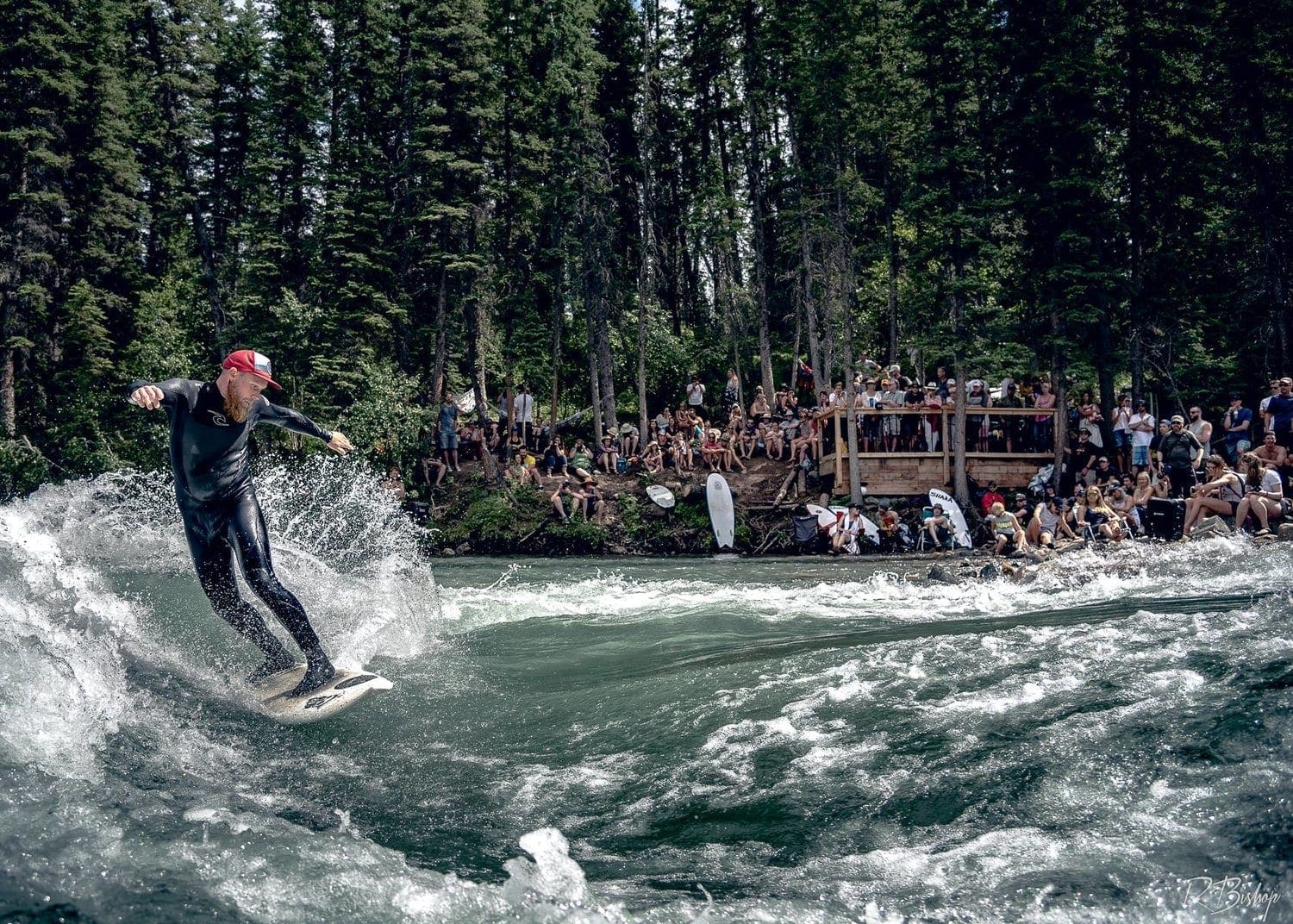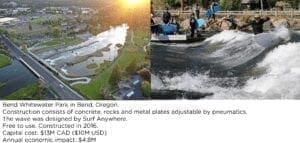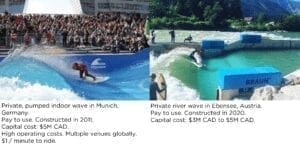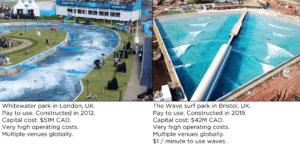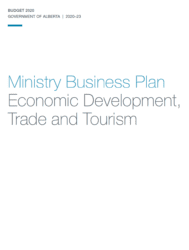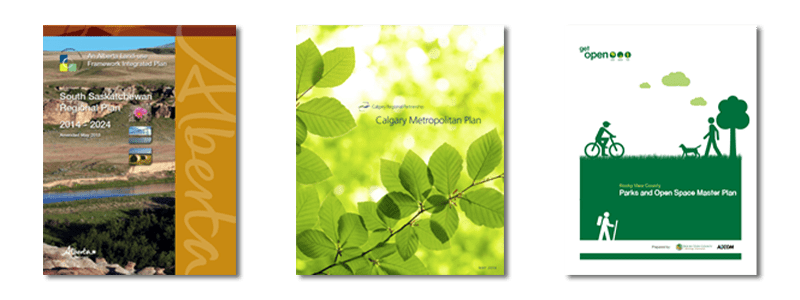The Cochrane River Wave Park Steering Committee is pleased to release the results of its Bow River Recreation Survey. The survey was completed between July 27 and September 15, 2021, and provides initial feedback and sentiment on the recreational use of the Bow River and the potential Cochrane River Wave Park.
This survey is the first step in a longer-term public engagement process and will be used to help shape how to move forward with the next steps regarding river recreation and/or a potential river wave park.
This is not a scientifically validated report. It simply reflects initial sentiment about river recreation broadly, and the potential idea of a river wave park (based on the current information available, which is limited).
An effort has been made to include summaries of comments and qualitative feedback, but any quantification of these comments is approximate. The steering committee would like to thank everyone who took the time to comment and provide input into this process.
Overview
The Cochrane River Wave Park is a conceptual project being explored as part of a broader vision to develop part of the Bow River into a recreational area for resident and tourist use. A feasibility study completed in 2020 determined a river wave is a possible option for Cochrane and is the source of the information available on this website.
The project is in the very early stages and no decisions have been made regarding how or if it will move forward. Public engagement is an important part of our process and will be ongoing. The first opportunity for engagement included a survey that is now closed. Thank you to everyone who provide input. A report of the findings and next steps will be produced and shared in the coming months.
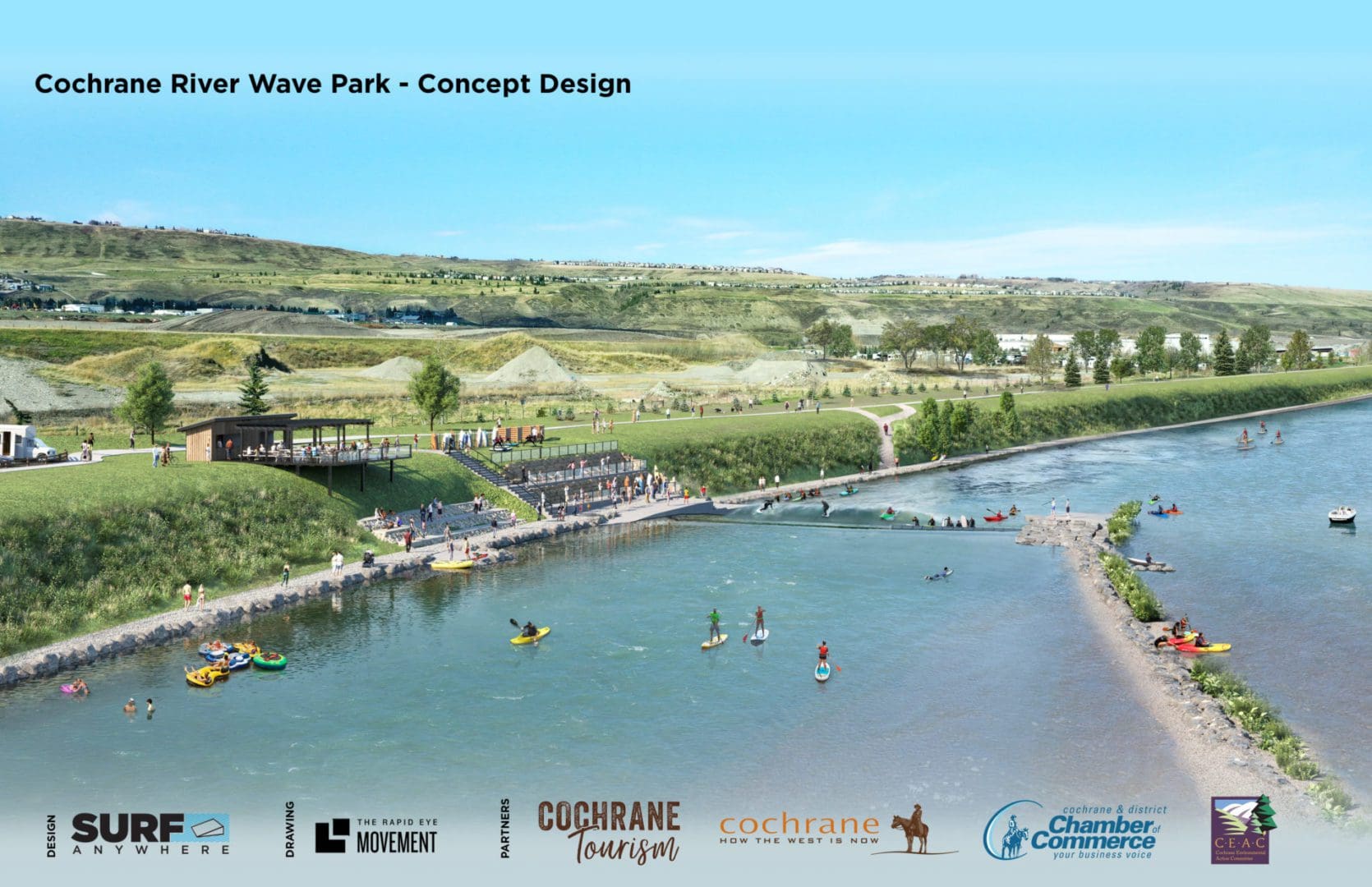
Conceptual drawing of what a potential River Wave Park could look like at the River Avenue Bridge in Cochrane. The total cost of the potential project – including construction – is estimated to be just under $10 million, including a 40 percent contingency.
Project Timeline
Several steps must be taken before a decision is made regarding whether a river wave is the right fit for Cochrane, or what a river recreational area could look like. We are committed to open, transparent communication as we engage the community and learn more about how people would like to use the Bow River in Cochrane.
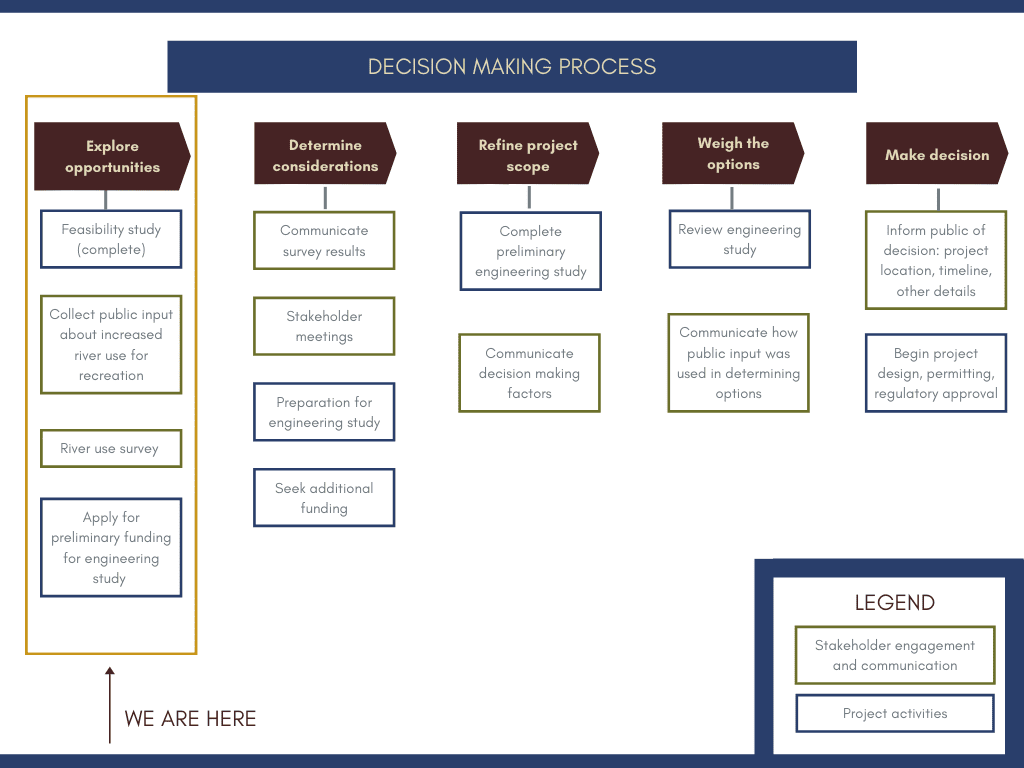
An important step is hearing from the public, and that’s where we are now. We are committed to open, transparent communication as we engage the community and learn more about how people would like to use the Bow River in Cochrane. The information collected through the survey will be used to help guide the decision-making process around what a river recreation area could look like along the Bow River, and whether a river wave should be part of that vision.
Project Benefits
The possible combination of river waves, recreational, educational opportunities, and environmental improvements could result in substantial cultural, economic, and environmental benefits that would last generations. If this project moves forward, it could capture some of the global surf tourism which is valued at $50 billion a year.
The feasibility study estimates the River Wave Park could generate $2,200,000 to $6,200,000 per year in new economic activity from wave users alone while generating millions of positive impressions every year from around the world. The Bend, Oregon, river wave park generated $4,800,000 in economic impacts in 2017 based on an economic impact study.
Potential elements of the project are outlined below.
THE WAVE

A good wave is a driver of economic activity. Good waves are scarce and in high demand. Global wave tourism is valued at $50 billion a year.
Good waves create a spectacle for people to come to the area and draw users, families, and businesses.
SUPPORTING FACILITY

A supporting facility could create a complete experience for the area. The facility would support wave, spectator, and recreational area usage during events, encouraging tourists to stay in Cochrane longer.
Possible amenities could include equipment rentals, lessons, warm-up, and cool-down areas, food and beverage services, and educational courses on river environment, safety, and history.
Casual floaters on the Bow River could use the facility as an endpoint and a shuttle pickup location to return to downtown or to the launch at Riverfront Park.
RIVER ACCESS
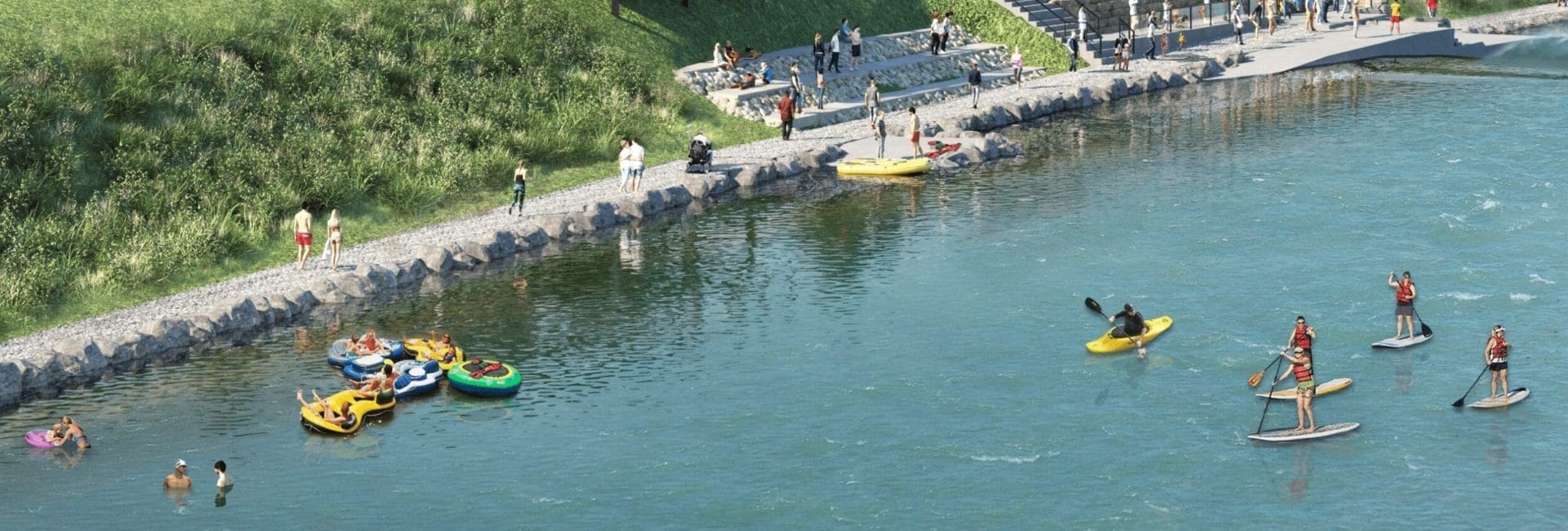
A key aspect of the project vision is improved river access that could provide a safe exit for casual floaters on the Cochrane Water Trail, easy access for people training in the flat water above the wave, and a convenient launch for people going downstream.
The river access could encourage people to safely connect with the river.
NATURAL CHANNEL

In the conceptual drawing, the south channel could be a natural channel that would ensure unobstructed fish and boat passage.
Portages could be built into the reinforced island along with improved riparian and fish habitat.
DOG PARK AND PATHWAY

The conceptual drawing of a potential River Wave Park at the River Avenue Bridge shows how the existing dog park and pathway would remain. The area could provide an improved experience for existing users.
CONCEPTUAL LAYOUT OF THE COCHRANE RIVER WAVE PARK

This conceptual layout shows two channels: One natural channel and one wave channel, and the supporting facility applies to any of the potential locations. The layout could be customized for the final location.
WATER TRAIL AND SHUTTLES

Map of proposed water trail and shuttles that could open up the river for recreational use and transport visitors around Cochrane.
POTENTIAL LOCATIONS
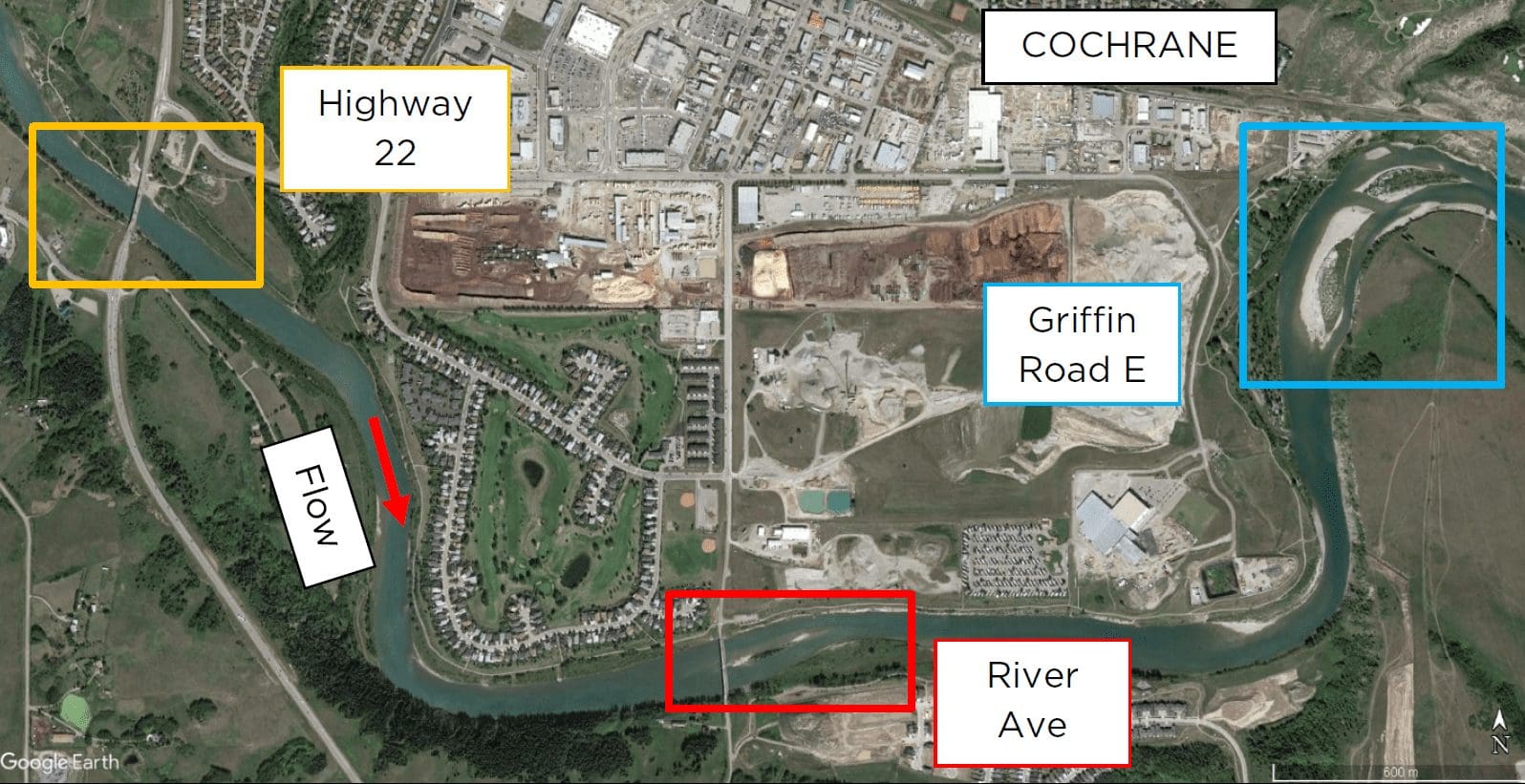
These are the possible locations for the potential Cochrane River Wave Park, based only on river elevations from the Highway 22 bridge out of Cochrane. There are other possible locations upstream of Highway 22 that could be considered if no other spots were viable. Selection will be based on many factors including stakeholder feedback, environmental factors, flood risk, cultural factors, navigation, and more.
About us
The Cochrane River Wave Park Steering Committee has been formed and is taking the lead role in exploring the potential for this project. The committee includes the following organizations that fully support the development of the Cochrane River Park:
Cochrane Tourism Association
Jo-Anne Oucharek
Co-Chair
Alberta Whitewater Association
Sara Jordan
Co-Chair
Alberta River Surfing Association
Neil Egsgard
Business Development (Town of Cochrane)
Mike Korman
Cochrane Fire Services (Town of Cochrane)
Scott Pletsch
Professional River Outfitters Association of Alberta
Shea Beaton
Cochrane Environmental Action Committee
Tim Geise
Cochrane & District Chamber of Commerce
Kelly Carson
For more information, contact Jo-Anne Oucharek, Co-chair of the Cochrane River Wave Park Steering Committee and Executive Director of the Cochrane Tourism Association at info@cochraneriverwavepark.com.
The project is in the very early stages and no decisions have been made regarding how or if it will move forward. Public engagement is an important part of our process and will be ongoing. The first opportunity for engagement included a survey that is now closed. Thank you to everyone who provide input. A report of the findings and next steps will be produced and shared in the coming months.


Project Supporters
Supporting organizations and representatives include:
Government
- Cochrane Mayor Genung
- Cochrane Town Councillor Fedeyko
- Cochrane & District Chamber of Commerce
- Economic Recovery Task Force
- Town of Cochrane Business Development
- Peter Guthrie, P. Eng, MLA Airdrie-Cochrane
- Blake Richards, MP, Banff-Airdrie
Business
- Aquabatics
- Cochrane Business Network
- Kelsey’s Caravan Adventure Hostel
- Hunter Valley Adventures
- Bruce Kendall, Business Developer’s Liaison
- Surf Anywhere
Not for profits
- Cochrane Environmental Action Committee
- Cochrane Rotary Club
- Cochrane Tourism
- Spray Lakes Sawmills Family Sports Centre
- Cochrane Lions
Provincial Wave User Associations
- Alberta River Surfing Association
- Alberta Whitewater Association
National Sports Organizations
- CSA Surf Canada
- Canoe Kayak Canada
This page is always under development providing updated information on this potential project.
Frequently Asked Questions
The following questions and answers have been developed based on the feasibility study, which was completed in 2020.
Last updated September 2021
Economic benefits, costs, and return on investments
The Cochrane River Wave Park could be a large driver of tourism that will attract new people to visit Alberta and encourage businesses and families to move to Alberta. The planning and construction process will employ Albertans.
Once operating, the project could generate over $5M each year in economic activity. This project aligns with the Alberta Government Economic Development, Trade, and Tourism: Ministry Business Plan 2020 – 2023. In particular, the project aligns with Key Objective 4.3 to “grow new, expanded and refreshed tourism products in support of destination and seasonal diversification.”
Global surf tourism is valued at $50 billion per year. The waves could generate between $1,800,000 to $6,000,000 a year in new economic activity from wave users alone. Alberta has only minimal surf-related economic activity and this would be a new economic activity. Existing river waves around the world generate millions a year in economic activity for the surrounding areas.
The Bend, Oregon, river wave park generated $4,800,000 in economic impacts in 2017.

As of 2020, the early budget cost is $9,970,000 including 40% contingency.
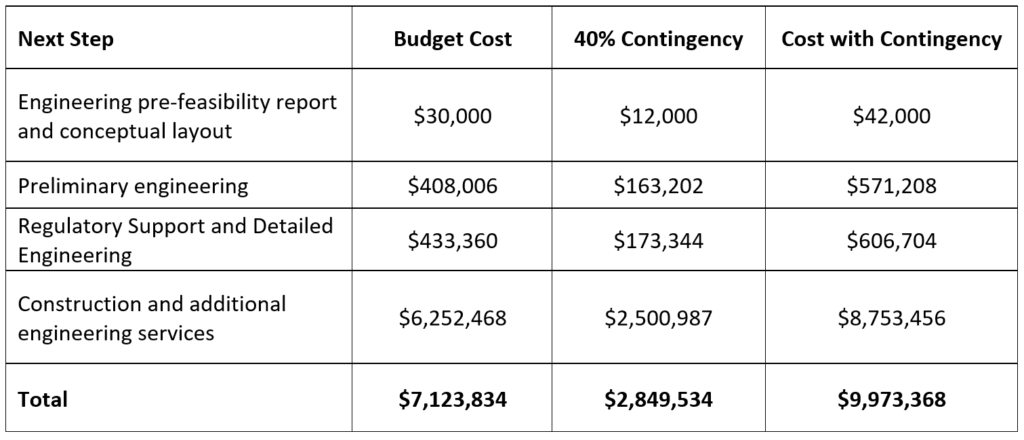
The return on investment is estimated to be between 3 to 7 years. Return on investment is based on 9 months of usage. The usage was calculated based on other facilities in similar climates. The 3 year ROI includes all river wave park users including spectators. The 7-year return only includes wave user spending with usage at 30% of capacity.

The average surfer spends $62.50 per surf session and makes on average $75,000 per year. The spending is based on lodgings, food, gas, equipment, and additional local spending.
The potential wave usage could provide a total of 100,000 two-hour-long surf sessions from March to November each year. This spending charts includes wave user spending and does not include spectator spending.
Spending numbers come from major US and UK studies of surfer spending.
Yes. River wave parks are proven economic activity generators with examples going back 35 years. Good, free-to-use river wave parks consistently generate millions in economic activity each year.
Every year there are new pumped wave facilities being constructed around the world that cost tens of millions of dollars and generate profits. There are multiple private, pay-to-use river wave parks around the world.
The current market rate for wave riding at a commercial facility is $1 / minute which means the wave usage at the Cochrane River Wave Park has a market value of over $3M at only 30% capacity.
The Cochrane wave would be predictable, if you plan a vacation a year in advance and spend thousands of dollars you know the waves will be there when you arrive. Wave users and spectators get more time with waves in one day in Cochrane than in a month at the ocean because river waves are always working.
Cochrane offers a huge variety of high-quality and other accessible attractions.
Yes, the economic impacts have taken Cochrane’s weather into account.
The winter months have no usage, spring and fall have reduced usage and the flood season has reduced usage. Wave users travel for predictable waves in cold weather.
There is heavy usage of the existing Kananaskis surf wave all year round. Bend, Oregon, with a similar river wave park has similar weather, and the park generated $4.8M in economic activity 1 year after opening. In the summer of 2017, the first full summer after opening, the Bend River Trail had 181,000 users. In all of 2017, the Bend River waves were estimated to have 17,000 to 33,000 visits and many times that the number of spectators.

Bend, Oregon, average temperatures

Cochrane, Alberta, average temperatures
There is no competition outside of the coasts and the southern United States. The closest good waves are over 1,000 kilometers away on the Pacific ocean.
The map below shows surf waves and is from MagicSeaweed (https://magicseaweed.com/). The light blue markers are ocean waves. The blue dots are consistent river waves. The red dot is the Project location.

In the US, houses within walking distance of a surf break showed that houses close to a surf break had an increased value of $100,000 compared to houses further away from a surf break.
At this time, no money is coming from the Town of Cochrane taxes and no money will be requested for the next few stages. The money for the project will come through a combination of community fundraising, local donations, local partnerships, corporate donations of goods and services, events, grants, and public funds.
Well-built river waves have very minimal ongoing costs. The design will make the minimal seasonal maintenance very easy to perform. If costs occur from major flood events, the Alberta River Surfing Assoc will cover these costs through a maintenance fund.
The lifespan, based on other parks is approx. 25 years.
If the project moves forward, the supporting facility would generate enough income to pay for the upgrades at the end of the lifespan as well as annual operating costs. Funds would be put away annually to pay for upgrades.
As per the recommendations in the feasibility study, the River Wave Park would be operated by a newly formed, local organization.
Indoor waves powered by pumps cost millions to build and when operating require the same amount of electricity as an entire neighbourhood.
Outdoor pool based waves cost tens of millions and also have high operating costs. Powered wave generation facilities have high user fees.
River wave park projects have minimal operating costs, improve the environment, operations do not contribute to climate change, can provide both free and pay-to-use wave recreation, and create a river trail.
Community Consultations
In 2020, project information was distributed to local organizations, all levels of government, and the surrounding community associations listed on the Town of Cochrane Community Associations Webpage.
Feedback has been gathered through the website, email, a survey, and the Town of Cochrane.
Community consultation is ongoing. The first opportunity for engagement included a survey that is now closed. Thank you to everyone who provide input. Feedback will continue to be collected via the feedback button on this website, comments to the Town of Cochrane, and public discussions with community members. Extensive community consultations and stakeholder outreach will continue as the project progresses. We are committed to open, transparent communication as we engage the community and learn more about how people would like to use the Bow River in Cochrane.
Using the Cochrane River Wave Park
The river wave park would be designed and planned for all to enjoy and will be used by large numbers of Cochrane Residents and visitors with thousands of visitors & users each year.
The river wave park could be used as a meeting place, a river access point, a recreation area, a classroom, a research area, and as a place to appreciate the river. The river wave park could be enjoyed by youth, adults, the elderly, surfers, rafters, swimmers, sunbathers, SUPers, casual floaters, paddlers, walkers, waders, environmentalists, and anyone who enjoys experiencing the river. The area could include access to the riverside for both river entrance and exit. The access could be mobility-friendly.
The area could become a safe and easy take-out and put-in point for Bow River floats and paddles.
Spectators and Sunbathers
The beautiful look and sound of the waves could provide a great background for people to enjoy the river. The river recreation would create lots of action for people to enjoy while relaxing on the sunny river banks and bridges.
Rafters & Floaters
The area would be safe for rafters and floaters and provide easy and safe entrance and exit from the river. The river upstream of the wave will be slow and deep making it easy for unskilled rafters and floaters to paddle to the bank. There could be ramps both upstream and downstream of the wave that allow easy river exit and entrance with small rafts. There would be signage notifying rafters and floaters of the wave and the river exits. Rafters and floaters would be able to avoid the wave by taking the south channel or getting out of the river and walking around. If rafters and floaters go over the wave, they would have a fun ride and may fall out of the raft and would then float downstream.
Swimmers
The area upstream of the wave would be slow-moving and deep and would provide a swimming area. Swimmers can go over the waves and would float through the waves and downstream without stopping.
SUPers & Paddlers
The flat and slow-moving water upstream of the wave and the access and exit ramps would provide an easy way for paddlers to leave and enter the river. Paddlers would be able to float over the wave and downstream.
Environmentalist and Nature Lovers
The eroding riverbanks would be stabilized and habitat improvements around the wave and would create a small and accessible natural area. The signage about the river ecosystem and positive river experiences would create good connections between people and the river and more people would care about protecting our rivers.
Students
The Cochrane River Wave Park could provide an engaging classroom for students to learn about how the river works, river ecosystems, river safety, and the physics of wave formation. The area could also allow for school surf competitions. The summer junior river safety & surf program would provide youth training on river safety, river usage, and provide improved river safety for all users.
Research
The river wave park could allow ongoing research into successful urban beach strategies and different ways to shape river waves.
Surfers, kayakers, and wave riders
The waves would provide excellent waves for all levels and types of waves users and become a major tourism destination.
Search & Rescue
Cochrane Fire Department would be able to conduct river rescue training under a variety of river conditions by using the adjustable wave structures. The river rescue training centre coulc offer rescue courses to other river rescue departments in the region and become an additional source of economic impact.

Example of river rescue training in Pemberton, BC
The vehicle is drained of all toxins, thoroughly cleaned, and chained to a concrete pad in the river bed to allow vehicle river rescue training.
Flood Risk
The wave would reduce flood risks because it creates more space in the river for water to flow. The structures that make the waves collapse to the river bottom. When the structures are flattened there is a decrease in current river levels. The structures would be flattened well in advance of flood times.
The aim of the potential river wave is to reduce ice jam formation. If the project moves forward, an extensive study of ice jam formation in the area and the effect the river wave park would have on ice jam formation would be completed. The design of the wave would be created to minimize ice jam formation.
Yes, the technology has been used across the world and functions extremely well in rivers like the Bow with high flows and lots of material being moved downriver.
Based on data from other facilities, waves and beaches would return to normal operation shortly after the high water recedes. Other facilities have gone through major floods and in different locations around the world. There have been minimal problems.
The structures are designed so that if there is a failure then they fully collapse. When the structures are collapsed they do not affect river levels.
If the proposed Glenmore east option was built, it would affect Cochrane and significantly change the river in town. During major flood events, the reservoir would submerge the river wave park . The River Ave. potential project area is outlined in red below. The dark blue line is the reservoir’s normal operating level. The light blue area is the maximum reservoir capacity during large flood events.
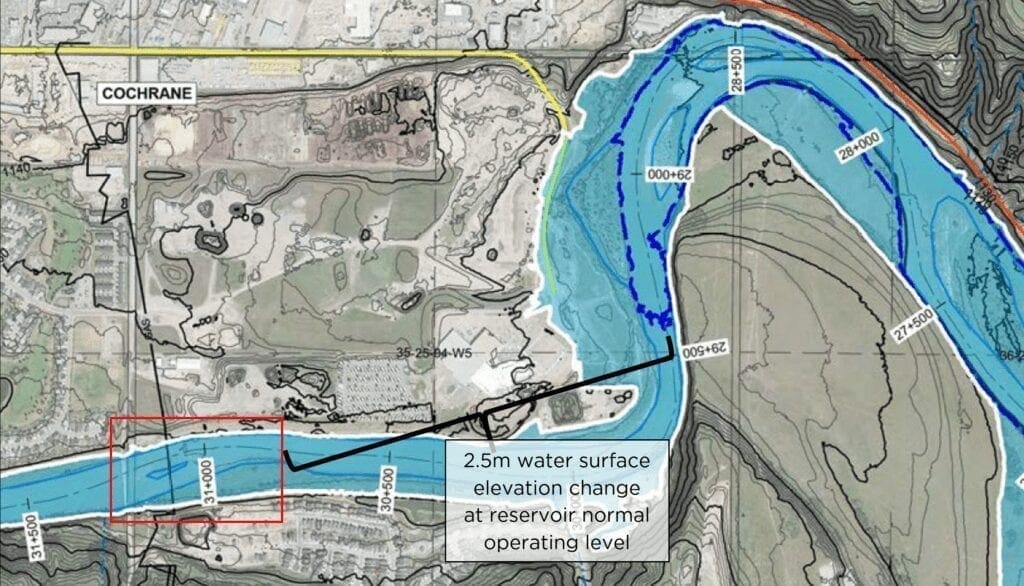
Key Technologies
River waves are created by controlling how the water flows from a high point. There are two key technologies involved, a water level controlling technology and a wave creating technology.
The water level technology controls the water level upstream of the waver and controls which wave(s) get water. This technology also makes it easy for future inspection and maintenance. The water level controlling technology is intended to be Obermeyer Gates or the equivalent. The gates consist of large plates anchored to a concrete foundation. The plates are raised and lowered by large bladders or hydraulics or pneumatics. There will be a way to mechanically and manually raise the gates should there be any equipment problems.
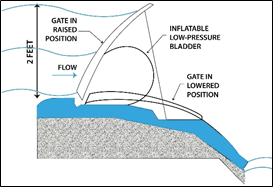
Side profile diagram of Obermeyer Gate

Lowered Gate
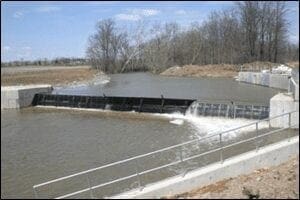
Raised Gate
The wave creating technology shapes the flow of water going from the upstream high point to the downstream low point. There are a number of different methods for creating waves with new methods under development. Existing wave shaping technologies will be identified and analyzed during the preliminary engineering phases.
The wave shaping technology will take advantage of the year-long research project into river wave formation by Surf Anywhere and the University of Ottawa.
Wave Details
Absolutely, good wave design and good construction result in good waves. Good river waves have been built in major rivers all around the world and good waves can be built in the Bow.
Cochrane Tourism Association is working with Surf Anywhere, a Calgary river wave consulting company, that has extensive experience building successful river waves in Canada and around the world for over a decade.
There would be one primary channel. The channel could form a single wave or multiple smaller waves in parallel. The waves would be up to 1.5m high from trough to peak.
Yes, the waves will be fully adjustable. The waves can be changed to make different shapes of waves and to make the best waves at all flows.
Yes, the conceptual plan includes boulder groins creating teaching eddies upstream of the wave, downstream of the wave, and on the island in both the river wave channel and the natural channel.
The conceptual plan will include a beach that would be public and free to use. Some wave times would be pay to use and some wave times would be free to use. This combination of free and pay balances accessibility with project sustaining revenue.
The waves are adjustable allowing for ideal features for all river users that want to ride waves including surfers, SUPers, bodyboarders, kayakers, body surfers, and others. The waves can be smooth green faces for big carves, whitewater holes, and other shapes.
The waves will be usable all year except for times of heavy ice coverage. pre-flood days and during floods. Current wave usage in Alberta and other locations shows that the waves will be used whenever they are operating.
Yes, the Alberta River Surfing Association and Surf Anywhere built an excellent surf wave in the Kananaskis called The Mountain in 2014 and upgraded it in 2019.
Surf Anywhere helps surfers and other river users build waves across Alberta, across Canada, and around the world. Surf Anywhere projects include the Mountain wave in the Kananaskis and the best-manufactured river surfing wave in North America in Bend, Oregon.
In 2020/2021, Surf Anywhere is conducting a year-long river wave research study with the University of Ottawa. Surf Anywhere also provides a wide range of other services to improve river wave experiences.
Safety
Yes, the Alberta River Surfing Assoc. is developing a river safety program that would provide trained river safety personnel. The program would include a junior river safety and surf program for youth each summer that would train young people on river safety, river rescue, river recreation, provide positive river experiences and develop a healthy culture of river safety and respect.
The conceptual plan has the river upstream developed to be slower and deeper, to allow for an easy and safe exit for rafters and would provide easier river access and easier river exits. The river passage through this section would be much safer for rafters and other river users.
The wave would be designed to have a deep section immediately after the wave. The adjustability of the wave would allow some control over river depth after the wave. The river would be deep immediately after the wave due to the movement of the water around the wave.
As river users move downstream, the river would become more shallow and be very similar to current conditions. The depth of the river would be impacted by flows with higher flows making the river deeper and lower flows making the river shallower.
The waves would be adjustable and can be quickly and completely flattened at any time. If nighttime usage is not desired, the waves could disappear every night and reappear every morning.
The design would include a number of spots for floaters to exit the river before the wave. The river before the wave is deep and slow making it easy to exit. Boats could safely float over the wave. There would be signage indicating the different routes and exits.
The RCMP, rescue, and fireboats could bypass the waves via the channel which will be unchanged. The waves could be completely flattened allowing the RCMP, rescue, and fireboats to go over the wave’s location.
Environmental Benefits & Impacts
As part of the construction, the nearby river habitat and the riverbank habitat would be improved. The improvements would make those areas better for the animals and plants that live there and that are there seasonally.
The project would be self-compensating meaning there would be an increase in good river habitat and riverbank habitat as a result of the project. The improvements at the wave would protect the area from further erosion while retaining natural elements of the area.
Large sections of eroding riverbank would be stabilized including the creation of habitat. Habitat on the island would be improved as part of the project.
The waves and urban beach would bring a lot of people to the area and create positive and memorable experiences with the river. The more people are aware of the river and have positive river experiences, the more they would care about protecting river health.
The area could be an excellent river ecosystem education location including signage for a large number of visitors and educational programming.
Yes, fish could easily be able to pass the waves. The Bow River has existed here for over 100 years.
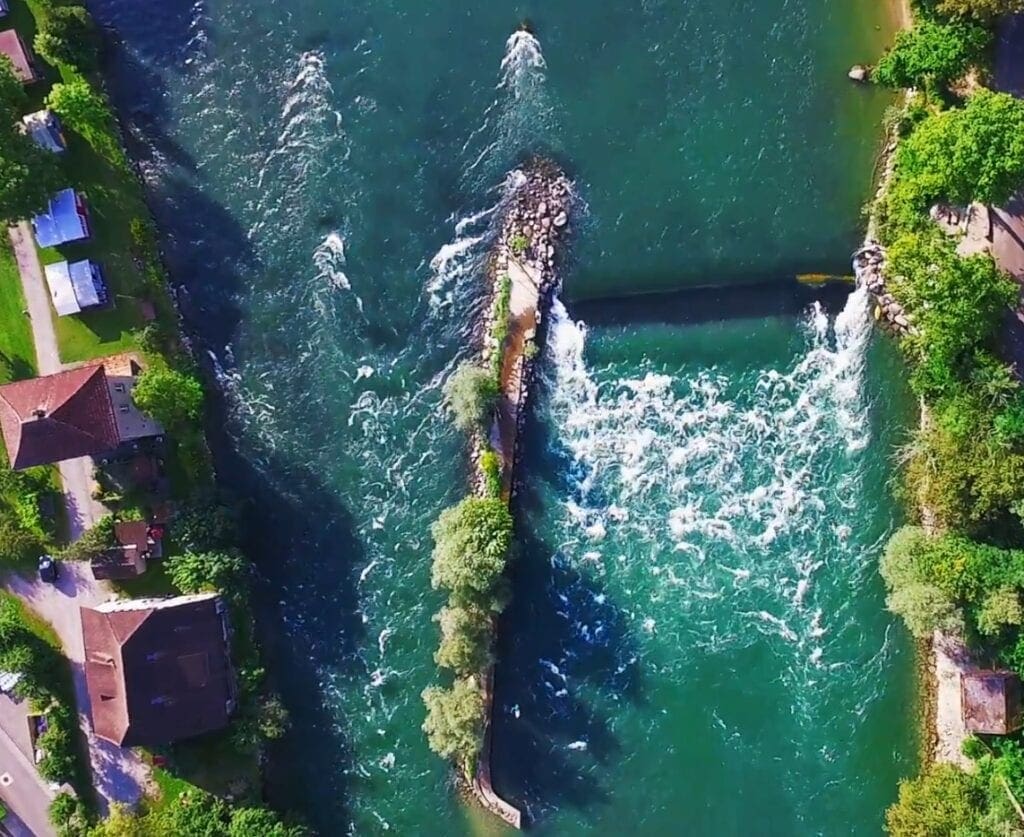
Yes, if the project moves forward, it would include a full environmental assessment. The environmental assessment would be used to help improve the area’s river (aquatic) and riparian (riverbank) habitat and avoid negative environmental impacts.
The feasibility study included a desktop environmental assessment based on the Alberta Government Landscape Analysis Tool (LAT) and the Department of Fisheries and Oceans Aquatic Species at Risk Report (ASRR).
The desktop assessment identified the following areas that need further review: endangered and threatened plant ranges, key wildlife and biodiversity areas, other sensitive and endangered species, sensitive raptor range, sharp-tailed grouse survey, chinook grasslands, foothills parkland grasslands, grassland, and parkland natural region and bull trout. This project could be an opportunity to improve habitat and have a substantial positive environmental impact.
Cultural Benefits
This project could take a minimally used section of the Cochrane riverfront and create a vibrant public gathering space and cultural anchor for most of the year.
Good recreational river waves are proven draws for users and spectators and become regularly used spaces for public events. The urban beach would create a low-risk space for people to enter, exit, experience, and connect with the Bow River.
The urban beach would be usable by everyone. Wave usage is a low impact and low-cost recreation. This means the waves can be enjoyed by all ages from children to seniors.
The conceptual design of the riverbank area would include sloped access between levels to allow for wheeled access such as wheelchairs and strollers.
The waves could provide an excellent training ground for surf and other wave-riding athletes. The waves would be free to use, very high quality, and are available for most of the year. This combination means athletes of all ages could spend many hours improving their skills and entertaining the spectators and beachgoers.
Wave users could easily start in Cochrane and end up representing Canada at the Olympics and other international events.
If the River Ave location was selected, the dog park would remain but there would be better and safer river access.
Parking and access management would be thoroughly examined in future stages of the project.
There could be are a variety of access solutions based on the location. This may include on-site parking, off-site parking with shuttle access, parking at the Spray Lakes Sawmill Family Sports Centre or a combination of options.
Noise and other impacts would be studied in detail during future stages of the project.
To manage noise, the Cochrane River Wave Park could be closed at night and at other sensitive times. The river waves are adjustable which means the river waves could be made to disappear at any time and the area usage will be minimal.
A variety of access options would be investigated to minimize the impact of usage on area residents.
The Town of Cochrane has published a Traffic Plan to improve traffic in Cochrane. An analysis of current and expected traffic patterns would be part of future stages in the project and the project design would incorporate the findings to minimize traffic impact.
Existing Area Plans
Yes. Many planning documents were reviewed and the project aligns with the following planning documents.
Provincial & Regional Plans
Town of Cochrane Plans

How to Support
We are looking for sponsors and partners for this high visibility legacy project that could permanently improve Cochrane. Supporters & Partners can provide funding, donations of services/materials, or other assistance.
For more information, please reach out to us directly at info@cochraneriverwavepark.com
Have any questions or comments?
We value everyone’s opinion and welcome all comments and questions!
Please send them to info@cochraneriverwavepark.com

